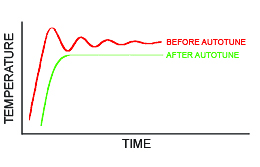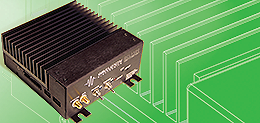
Often, temperature control instruments come with an Autotune function. Each manufacturer boasts their own proprietary algorithm. For maximum temperature stability, the control system parameters need to be matched to the thermoelectric, load, and sensor. Autotune uses the onboard processors to sample the system’s response to changing current and calculates the optimal Proportional Gain (P), Integrator Time Constant (I), and Derivative term (D). Our LFI3751 temperature controller allows two different kinds of optimization: Setpoint Response (AutS) where fastest time to temperature and minimal overshoot is the goal, or Disturbance Rejection (AutD) where maximum temperature stability is the goal despite changing conditions such as in pulsed laser diode systems. The Current Limit setting can be used in conjunction with Autotune to further optimize stability. Setting the current limit at the maximum thermoelectric level can cause overshoot in a fast load or if the AutD is used, leading to a long time to temperature. If you run Autotune at several current limit settings (below the maximum) you can further minimize time to temperature. Note that all PID parameters that Autotune calculates can be translated into settings for any Wavelength linear controller. Contact Technical Support for more information.

Subscribe to our newsletter for tips, techniques & product updates.
How do I decide which thermal sensor to use in my system? What shapes do they come in? How do I attach them to my device? These are typical design questions our technical support engineers help sort through every day.
When precision temperature control is required, thermistors offer the best stability in a closed-loop system. If operation will be over a wide range of temperatures, more than 50°C away from ambient, thermistors are not the best. RTDs or some of the linear, integrated circuit sensors may be more appropriate.
Can you embed the sensor in the device you’re controlling or in a metal plate near the device? Does it need to sit on the surface of a crystal? Do you need to worry about an epoxy or thermal paste outgassing into your system environment?
Our Application Note AN-TC11: Thermistor Basics details answers to many of these questions.
If you have more questions, contact Technical Support.
Wavelength designed the QCL LAB and TC LAB instruments with the touchscreen interface to be upgradeable in the field. New TCLAB firmware is available – for free. Version 1.7 can be downloaded here. The upgrade gives full access to IntelliTune. For instructions on how to upgrade the firmware, see the datasheet here.
In some medical systems, the laser diode anode must be grounded. In other cases, the cathode must be grounded. There are some systems where the laser diode power supply must be floated so the optical table can be wired to ground to reduce system noise. Adding computer control also complicates grounding. Our Application Note AN-LD16: Grounding with Special Laser Diode Configurations discusses these situations and offers guidance for implementing them.
We invite you to contribute topic suggestions, questions, and general feedback. Wavelength will incorporate as much reader input as possible.
Click to Submit





